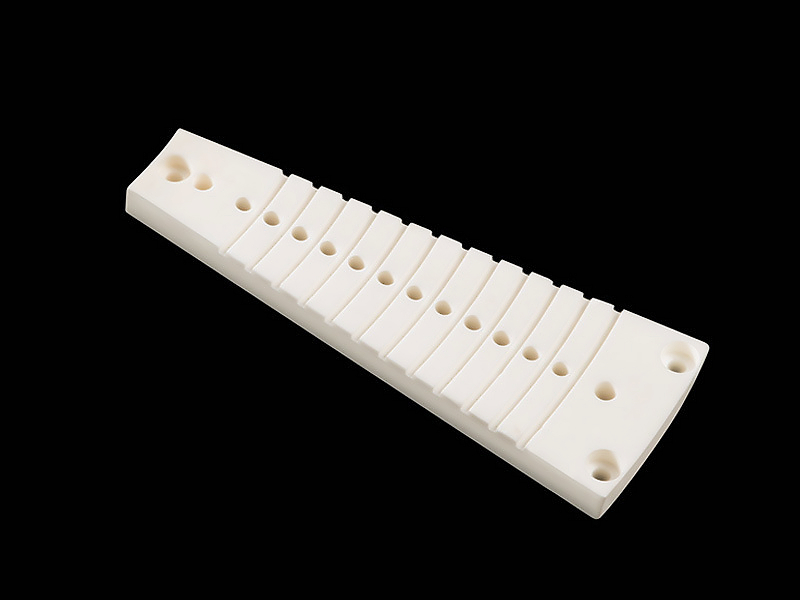Unlock the Power of Alumina (Al2O3) with Precision CNC Machining for Wear-Resistant Parts
Introduction
Alumina (Al₂O₃), a robust engineering ceramic, is widely recognized for its exceptional hardness, wear resistance, and thermal stability. Through precision CNC machining services, alumina components achieve outstanding dimensional accuracy (±0.01 mm) and superior surface finishes (Ra ≤0.5 µm), making them ideal for demanding applications in industries such as industrial equipment, medical devices, and automation. High-quality alumina CNC machined parts significantly enhance reliability and extend the lifespan of equipment components such as wear-resistant bearings, seals, insulators, and valve components.
By leveraging advanced CNC machining technologies, manufacturers produce custom alumina parts that meet stringent specifications, ensuring reliable performance under harsh operating conditions.
Alumina Material Properties
Material Performance Comparison Table
Material | Flexural Strength (MPa) | Hardness (HV) | Density (g/cm³) | Fracture Toughness (MPa√m) | Thermal Conductivity (W/m·K) | Typical Applications | Advantages |
|---|---|---|---|---|---|---|---|
350-400 | 1700-2100 HV | 3.90 | 4-5 MPa√m | 25-35 | Wear-resistant bearings, seals, electrical insulators | Exceptional hardness, abrasion resistance, electrical insulation | |
800-1100 | 1200-1400 HV | 6.05 | 5-10 MPa√m | 2.5-3.0 | Biomedical implants, turbine blades | High fracture toughness, high strength | |
400-500 | 2500-2800 HV | 3.20 | 4-5 MPa√m | 120-150 | Mechanical seals, abrasive tooling | Superior thermal conductivity, extreme hardness |
Alumina Selection Criteria
Choosing alumina for CNC machining involves evaluating its mechanical and thermal properties, specifically high hardness (1700-2100 HV), excellent abrasion resistance, and good thermal conductivity (25-35 W/m·K):
Alumina (Al₂O₃) is optimal for parts experiencing severe wear or requiring electrical insulation. Its hardness and abrasion resistance ensures long-lasting performance in industrial equipment such as bearings, pump seals, and insulating components.
Zirconia (ZrO₂) is preferred for components demanding high fracture toughness and mechanical strength, such as biomedical implants or aerospace turbine components.
Silicon Carbide (SiC) is ideal where excellent thermal conductivity and extreme wear resistance are critical, like mechanical seals in high-temperature applications.
CNC Machining Techniques for Alumina
CNC Machining Process Comparison
CNC Machining Technology | Dimensional Accuracy (mm) | Surface Roughness (Ra µm) | Typical Applications | Key Advantages |
|---|---|---|---|---|
±0.01 | 0.4-0.8 | Complex shaped components, precision fixtures | Precision shaping, minimal micro-cracking | |
±0.005 | 0.05-0.2 | Seals, bearings, precision mating surfaces | Ultra-fine surface finish, tight dimensional control | |
±0.01 | 0.8-1.2 | Mounting holes, fluid channels | Accurate hole placement, efficient drilling | |
±0.005-0.01 | 0.2-0.6 | Complex, intricate alumina parts | High complexity, excellent dimensional accuracy |
CNC Process Selection Strategy
Selecting the right machining method ensures the optimal performance and durability of alumina components:
CNC Milling allows intricate shaping and accurate feature detailing, ideal for complex geometries with precision tolerances and minimal surface defects.
CNC Grinding achieves ultra-smooth finishes (Ra ≤0.2 µm) required for sealing surfaces, bearings, and other high-precision mating components.
CNC Drilling ensures precise hole positioning, which is crucial for fluid-handling components and mounting assemblies.
Multi-Axis CNC Machining efficiently produces intricate alumina components with multiple angled features, significantly reducing setup times and enhancing precision.
Surface Treatments for CNC Alumina Components
Surface Treatment Comparison
Treatment Method | Hardness (HV) | Corrosion Resistance | Max Operating Temp (°C) | Typical Applications | Key Features |
|---|---|---|---|---|---|
2200-2600 HV | Excellent | 1200°C | Bearings, mechanical seals | Enhanced wear resistance, high thermal stability | |
2000-2100 HV | Excellent | 1000°C | Precision sealing components, insulators | Extremely smooth finish, improved corrosion protection | |
1800-2400 HV | Very Good | 900°C | Abrasive-resistant components, tooling | Superior hardness, extended component life | |
2000-2500 HV | Excellent | 1300°C | High-temp valves, combustion liners | Thermal insulation, superior durability |
Surface Treatment Selection Strategy
Selecting appropriate surface treatments maximizes the performance and longevity of alumina parts:
Ceramic Coating significantly boosts hardness (up to 2600 HV) and thermal stability, optimal for high-wear components in severe operating conditions.
Electropolishing provides exceptionally smooth surfaces, enhancing corrosion resistance and sealing capabilities for precision applications.
PVD Coating enhances abrasion resistance and component durability, suitable for tooling and high-friction applications.
Thermal Barrier Coating (TBC) ensures excellent thermal insulation and wear protection, ideal for high-temperature alumina components in industrial settings.
Typical Prototyping Methods
Ceramic 3D Printing: Enables rapid prototyping of complex alumina parts with precision layer thickness down to 25 µm.
CNC Machining Prototyping: Ideal for high-precision prototypes, ensuring dimensional tolerances as tight as ±0.01 mm.
Powder Bed Fusion: Offers accuracy and repeatability and is suitable for detailed and intricate alumina component prototypes.
Quality Assurance for Alumina CNC Machined Parts
Precision machined alumina components undergo rigorous quality checks:
CMM Inspection: Ensuring dimensional accuracy within ±0.01 mm using Coordinate Measuring Machines.
Surface Finish Analysis: Profilometer measurements verifying surface roughness (Ra ≤0.5 µm).
Mechanical Property Testing: Flexural strength and hardness tests per ASTM C1161 and ASTM C1327 standards.
Non-Destructive Testing (NDT): Ultrasonic inspections to detect micro-cracks or internal defects.
Thermal Resistance Testing: Evaluating thermal stability at operating temperatures up to 1200°C.
ISO 9001 Compliance: Ensuring consistent quality, traceability, and documentation standards.
Key Industry Applications
Wear-resistant bearings and mechanical seals
Precision valve and pump components
Electrical insulators for high-voltage equipment
Abrasion-resistant tooling and fixtures
Related FAQs:
Why choose alumina for CNC machining of wear-resistant parts?
What CNC machining processes are best for precision alumina components?
How do surface treatments enhance alumina part durability?
What quality measures ensure the reliability of CNC machined alumina components?
What industries commonly utilize alumina CNC machined parts?

